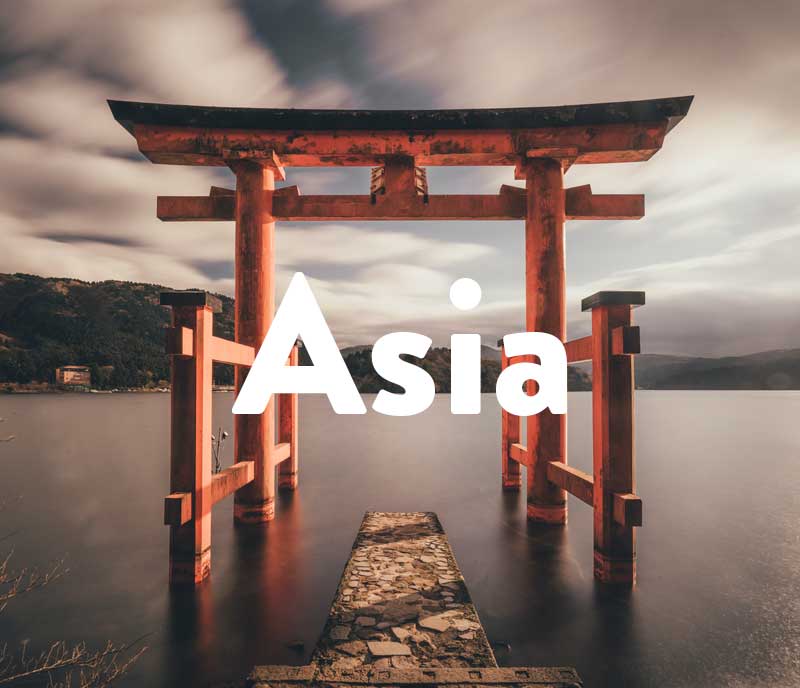At the moment, Japan is bang on trend. The country of the rising sun combines modern Western life with traditional ways of life like no other. It’s probably just this that makes Japan so exciting.
Manga and sushi have long become comic and gasto trends. In the pulsing city of Tokyo, you can visit beautiful old Buddist temples, while overnighting in futuristic capsule hotels. Under cherry blossom trees, countless admirers wonderingly take in the sights of Tokyo each year. And over it all, the Fujiyama towers up in snow-covered beauty.
Dive into our (free) travel guides below!
.
.
.
.
.
.
.
.
The Key Info
Japan is an island country, which comprises 6852 islands along the east coast of Asia. With a total area of 377,975 km², it is the fourth biggest island country in the world. The five main islands are Hokkaidō, Honshū, Shikoku, Kyūshū and Okinawa.
Japan shares no borders with other countries. However, Russia, North Korea, South Korea, China and Taiwan are all neighboring countries.
Since the country stretches over 3000 km from north to south, there are different climate conditions in Japan, ranging from a cold-temperate climate zone in Hokkaidō (snowy winter) to subtropical conditions in Okinawa (beach vacations possible).
The population speaks Japanese, but you can mostly communicate in English in large cities and tourist areas.
Japan in Numbers
- Population: 125,76 Millionen
- Total size of the country: 377,975 km²
- Capital city: Tokio
- Currency: Yen (JPY)
- Official language: Japanese
- Religion: Religious beliefs coexist in Japan. 80% of the population belong to Shintō and to Buddhism at the same time.
The 5 Biggest Cities in Japan
#1 Tokyo
With 8.9 million people living in the metropolitan area and approximately 35 million people in the greater Tokyo area, this city is the largest in the world. The Shibuya district, with its countless cafés, restaurants, shops and a correspondingly large number of flashing advertising signs, is a popular district, particularly among younger people. You’ve probably seen pictures of the famous Shibuya crossing. It is basically synonymous with Japanese big city flair.
#2 Yokohama
Yokohama is located south of Tokyo and can be reached in half an hour by train from there. The population, which nowadays numbers 3.7 million, received a brand new district in the mid-1980s, which was developed where old port facilities were before. Minato Mirai 21, which means “Port of the Future”, is a huge visitor magnet. There are hotels, shopping centers, an amusement park and museums – for example the Instant Noodle Museum, where you can create your own noodle combinations.
#3 Osaka
Osaka’s local cuisine includes some of the country’s most popular dishes, such as octopus balls or savory Japanese pancakes. You can eat your way through the entire culinary program at inexpensive food stands in this city of 2.7 million. The pretty castle park is ideal for a digestive walk.
#4 Nagoya
Annually, 9 million visitors arrive wanting to see the Atsuta-Jingu, one of the most important Shinto shrines in Japan. It can definitely get busy as a result so get there early if you want to avoid the crowds. Just 2.26 million people live in Nagoya.
#5 Sapporo
Sapporo became famous for hosting the 1972 Winter Olympics. The 1.95 million inhabitants enjoy great snow conditions in winter, and have well-equipped resorts to accommodate skiers from November to May. The snow festival, which takes place annually in February, is popular and worth seeing.
TOP Tourist Attractions
#1 The Fujiyama
The 3776 m high, snow-capped volcano, Fujiyama, is a popular motif in art and photography. On clear days, the highest mountain in Japan can be seen from many viewing platforms in Tokyo (for example from the Bunkyo Civic Center). With a little luck, you can also see it on the approach to Tokyo or if you travel on the Shinkansen (Japan’s high-speed train) from Tokyo to Osaka. You can also climb it in summer. The ascent takes between 3 and 8 hours.
#2 Kyoto
Kyoto is one of the best places to immerse yourself in the cultural history of Japan. The ancient streets, Buddhist architecture and well-preserved temples (mainly in the eastern part) make Kyoto one of the most visited cities in Japan. A detour to the almost unreal bamboo forest in Arashiyama west of the city center should not be missed. Both truly historic, Kyoto and the bamboo forest are highly instagrammable.
#3 Nara Park
In Nara Park, you won’t just find temples, but also 1200 sika deer, which roam freely there, and are not at all afraid of people. Some of them have learned to bow to visitors for food – you can buy crackers for the deer in the park. The cherry blossom is particularly beautiful in the park.
#4 Jigokudani Monkey Park
Another “animal” highlight in Japan is the Jigokudani Monkey Park near the city of Yamanouchi. In winter, you can watch snow monkeys bathing in the park’s hot springs – a wonderful sight! In the evening they disappear again into the surrounding forests.
# 5 Seven Public Baths Walk in Kinosaki Onsen
Kinosaki Onsen is one of the most beautiful spa and bathing resorts in Japan. An ‘onsen’ is a thermal bath or hotel with access to hot springs fed by volcanoes. There are seven public baths in Kinosaki that can be tried on the Seven Baths Trail. During your stay, you can borrow Japanese bathrobes and shoes. To hike through this romantic place, on the way from source to source, past small shops and willow-lined rivers, is a wonderful and uniquely Japanese experience.
Best Time to Visit
Since it can get very humid in some parts of the country in summer, the months in spring and autumn are generally best for traveling to Japan. But naturally it depends on what you would like to see and which parts of the country you are visiting.
Skiing is possible from December to April in the north of the country (preferably Hokkaidō).
The Japanese cherry trees blossom in most cities between mid-March and early April. If you want to experience this highlight, you should book early.
Safety for travelers
The crime rate in Japan is low and physical attacks are rare. However, you should be prepared for potential pickpockets in large cities and tourist areas. The use of date rape drugs has also occurred in bars in busy areas, especially in the evening. Never leave drinks unattended.
In south and west Japan, typhoons could occur. Look up the weather before you travel to your destination.
Homosexuality is completely legal in Japan.
The Most Important Holidays in Japan
- January 1: New Year’s Day
- Second Monday in January: Coming of Age Day
- February 11th: National Foundation Day
- 23 February: Birthday of the Emperor
- Around March 20th: early spring
- April 29th: Shōwa Day (Golden Week)
- May 3rd: Constitutional Memorial Day (Golden Week)
- May 4th: Greenery Day (Golden Week)
- May 5th: Children’s Day (Golden Week)
- July 23: Marine Day
- July 24th: Sports Day
- August 10: Mountain Day
- September 21: Respect for the Aged Day
- September 22nd: beginning of autumn
- November 3rd: Culture Day
- November 23: Thanksgiving (Labour Thanksgiving Day)
Visa for Japan
More travelers from the EU are able to travel up to 90 days without a visa in Japan. However, you do have to fill out a ‘landing permission’ to produce at the airport.
Currency
The currency in Japan is the yen (JPY). There are 10,000, 5,000, 2,000 and 1,000 yen notes in circulation.
Paying and withdrawing money with your credit card is no problem.
DOs and DON´Ts in Japan
Japan has its own particular rules and expectations. But the Japanese know this and will forgive you if you act a little strangely in their eyes. Note the following and to be on the safe side:
| Do | Don’t |
| If food is offered to you, try it even if you don’t recognize it or if it looks unusual. | Ever point at anything with chopsticks or stick them vertically into the rice. |
| Sip soup loudly. It’s a sign that it tastes good and is respectful. | Do not tip! (This is perceived as impolite as service is self-evident here). |
| If the glass of the person sitting next to you is empty, refill it for them (in Japan you shouldn’t refill the glass for yourself) | Never sit down on a seat without being asked (there is usually a fixed seating arrangement). |
| If the glass of the person sitting next to you is empty, refill it for them (in Japan you shouldn’t refill the glass for yourself) | Do not drink from your glass before toasting (in Japan you wait until after toasting). |
| Place your shoes with your toes neatly towards the door. So you can quickly slip back in later. Use the guest slippers provided. | Do not drink from your glass before toasting (in Japan you wait until after toasting). |
| Don’t refill your own glass when it is empty. |
Your pack list for Japan
In Japan, many hotels will provide toiletries, slippers, and even pyjamas for free. However, the rooms are often tiny. You should therefore concentrate on keeping your luggage as compact as possible. Here’s what you should bring though:
- Rain coat
- Weather-appropriate clothes
- Any medication you’ll need
- Socket adaptor
- Smartphone and cable
- A translation app for Japanese (Google Translate can even read signs to a certain degree – use the photo function.)
- A pen for filling out documents.
Secret Tips from Bloggers
- Get some shopping time in, says the Geeky Explorer. Getting lost in a 100-yen store or taking a trip to Tokyo Hands is fun and ensures that you bring home some fun souvenirs!
- Ryokou Girl suggests getting a feel for the bustle of Japan’s capital by starting out your visit at the Shibuya Scramble Crossing – the busiest crossing in the world.
- If you’re looking to explore some Japanese castles while you’re in the country, check out the Japanese Castle Explorer, with castle maps and juicy tips on every page.
TOP 7 Instagrammable Places
#asakusatemple (93,575 posts)
#arashiyamabambooforest (77,110 posts)
#meguroriver (62,196 posts)
#skytreetower (37,549 posts)
#jigokudani (33,208 posts)
#nezushrine (16,969 posts)
#pissalley (11,911 posts)
Did you know – Fun Facts about Japan
… that on average, Japanese women live to be 87.1 years old?
… that Japanese toilets are kitted out with recordings of music or sounds, so that your neighbor in the toilet next door doesn’t have to be party to your ‘noisier’ business?
… that taxi doors open by themselves in Japan?
Keep going with our latest posts!
- Your ultimate guide to hiking
- Dresden and Saxon Switzerland – The perfect weekend trip
- Vacation in Carinthia: Experience the sunny side of the Austrian Alps
- Craft Unforgettable Postcards: Say Goodbye to Writer’s Block with AI (Coming soon!)
- Discovering the Charm of San Antonio: 5 Hidden Must-Visit Places







